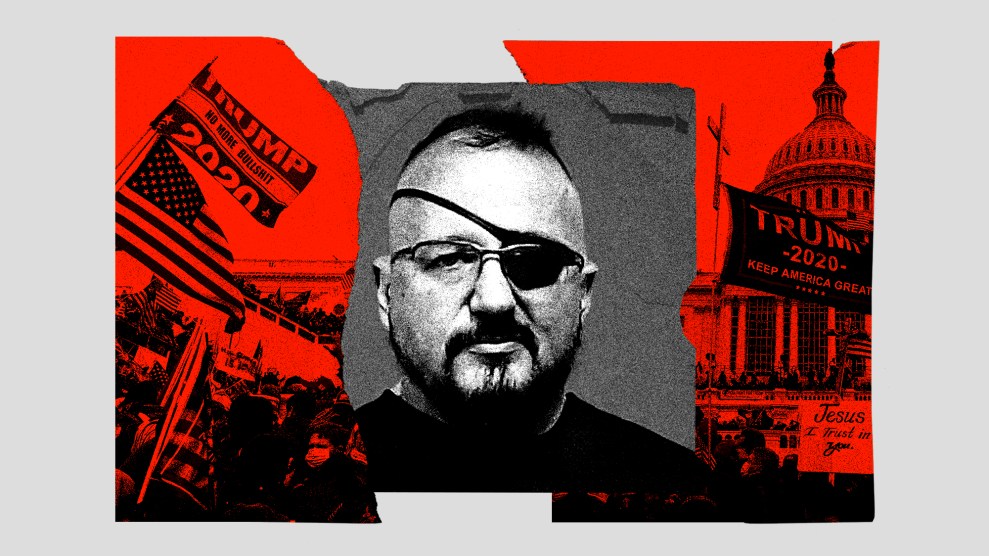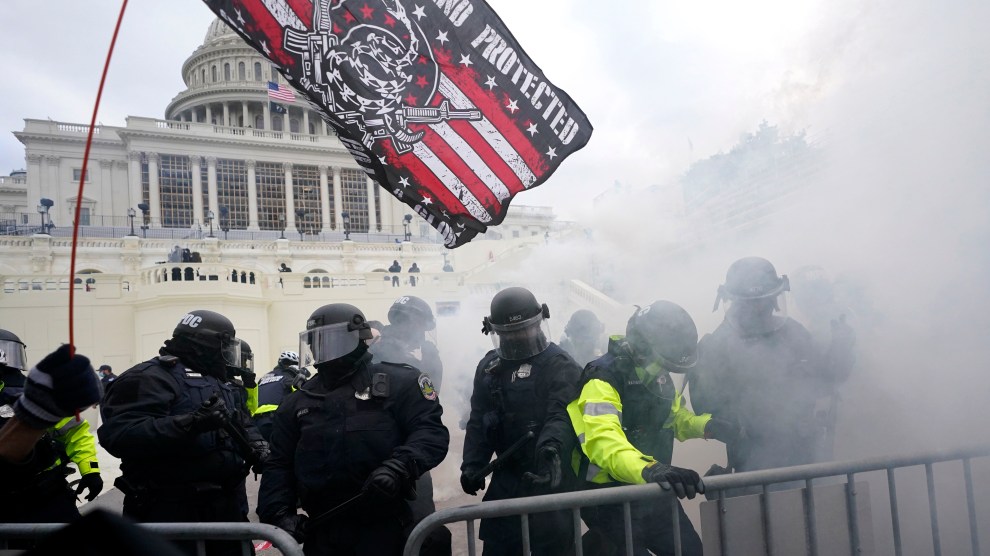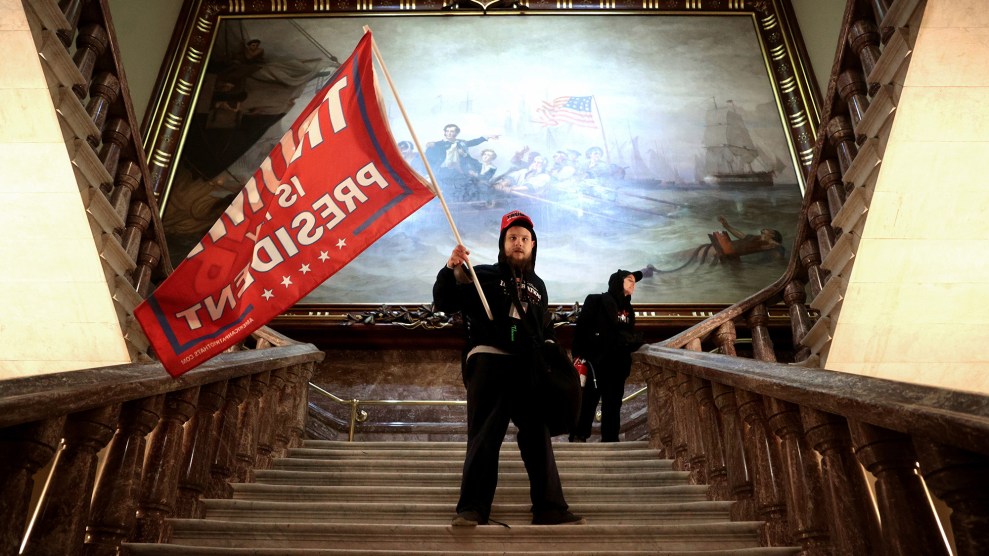The work of photographer Nate Gowdy should be familiar to regular Mother Jones readers, especially those who’ve followed our January 6 reporting. His black-and-white photos captured the chaos as protesters marched from the “Stop the Steal” rally to the explosive swarming of the US Capitol. Gowdy’s new book, Insurrection, is among the first photo books published to focus exclusively on that historical day. The book moves readers through the day in timestamped, chronological order, bringing them a first-hand, up-close account of not just the insurrection, but what it was like to be a journalist on the front lines of a battle for democracy.

What led you to DC to cover the events of January 6?
I’m drawn to photographing this American political era. Since 2015, my self-assigned and self-funded coverage has taken me to more than 300 events and demonstrations across the sociopolitical divide, including 35 official MAGA rallies and Trump appearances. The series, Vote American!, today spans 25 states and the nation’s capital.
At the end of 2020, I was in Indiana with family for our first holiday together since unexpectedly losing Mom eleven months earlier, likely due to Covid-19. I wanted to catch one last MAGA roadshow before the peaceful transition of power on January 20, but wasn’t entirely prepared, only packing my wide-lens camera, a Leica Q, just in case.
Fortunately, airline rates were better than I’d anticipated. I booked flights to Georgia for the historic Senate runoffs and then to Washington, DC, in time for what I perceived as Trump’s “last stand” on January 6—his so-called “Save America” rally at the Ellipse. To boot, Rolling Stone said they wanted to put me on assignment for that—my second time working with them.
On January 5, what were you expecting the next day? What did you think you’d be photographing? Did you think it’d get violent?
My flight that evening helped prepare me for what lay ahead. I’d never been aboard a plane where the dichotomy of people’s views was so in your face, with white Trump supporters in red hats and MAGA paraphernalia seated beside passengers, predominantly of color, just trying to travel from one place to another in peace. Instead, we were assaulted with repeated chants of “Four More Years” and “USA!” the entire flight.
Every pro-Trump gathering is its own special bubble of toxic Americana, so I always banked on January 6 being ridiculous. That said, I didn’t foresee the day turning deadly.
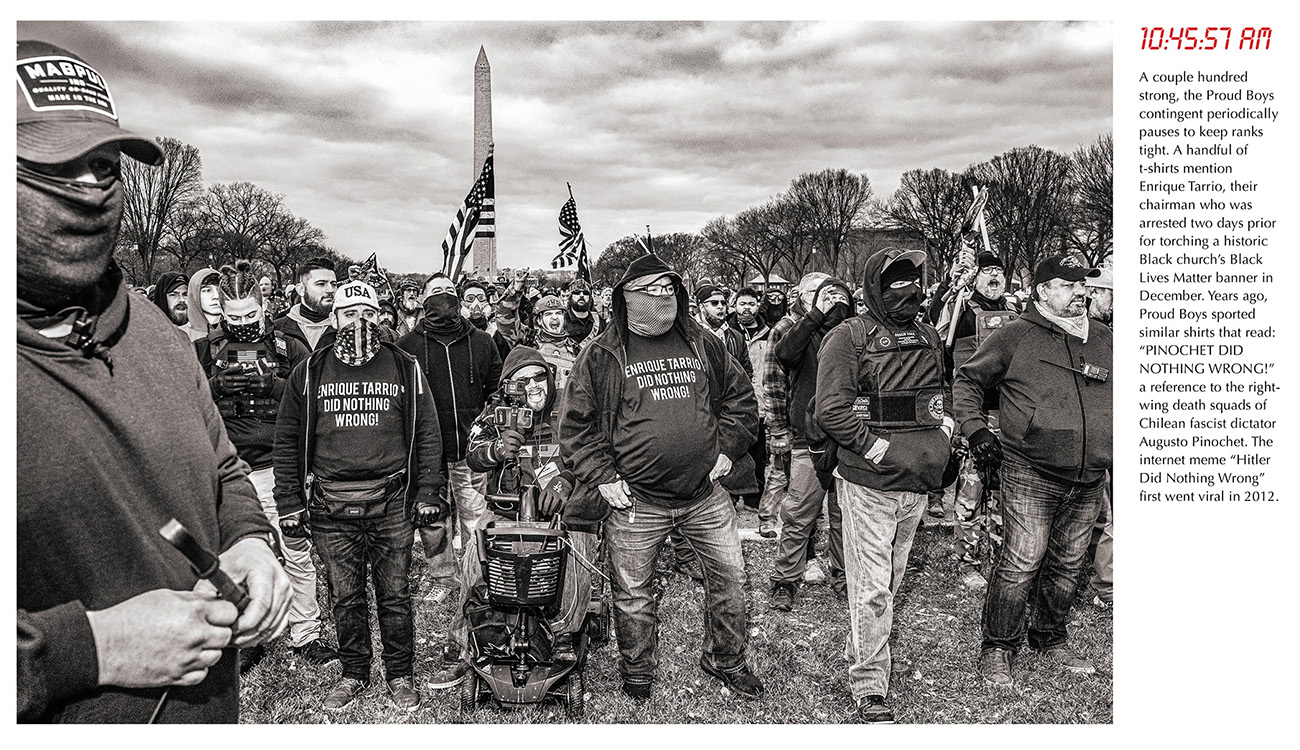
At what point on January 6 did you sense things were shifting from just another rally?
January 6 was different from the start. My day began with an encounter with the Proud Boys at the National Mall. The gang chanted “Fuck Antifa!” as it marched toward the Capitol. Within ten minutes, I was attacked and accused of being “Antifa” and “fake news.” Half an hour later, the militants kneeled for a sort of prewar prayer to ask God’s blessing on what they were about to do.
When they passed a small cluster of Capitol police, I was surprised when some men confronted the officers, yelling things like, “Don’t make us go against you!” and “Pick a side!”
After posing for group photos at the Capitol’s east front, they marched to food trucks lined along Constitution Avenue, arriving shortly after noon. I watched them mingle and gorge on hot dogs and tacos for lunch.
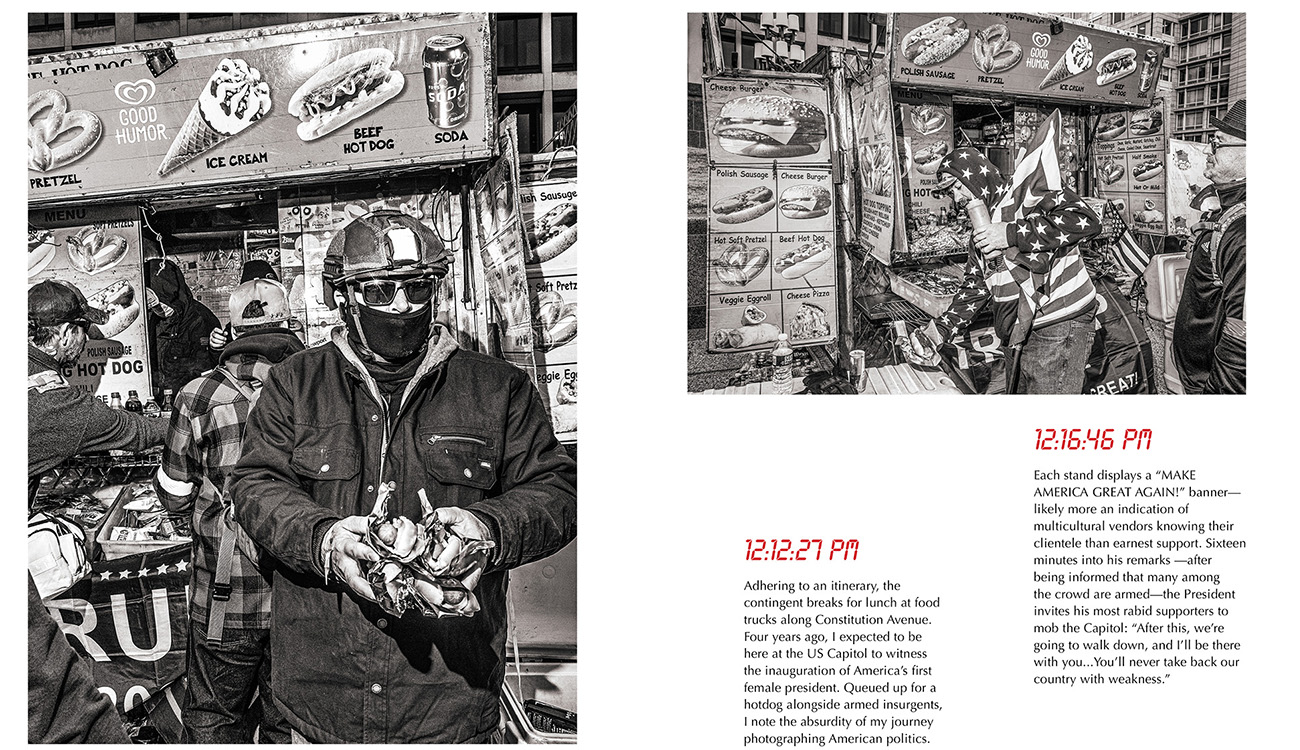
The Proud Boys got in formation again, marching to the Peace Monument at the Capitol Grounds’ northwest approach. As howls of “1776!” and “Fight for Trump!” reached a fever pitch, I was caught in a sea of war cries, adrenaline, and surging bodies. The mob swiftly overpowered five police patrols.
At 12:54 p.m., the mob flooded across the overturned steel barriers. That’s when any pretense that these people were part of anything remotely resembling “peaceful protest” ended. The president’s words and actions had animated thousands of his followers to besiege the Capitol. These people believed they had to attack our democracy in order to save it, an outrageous manipulation by a president intent on staying in power.
What was the crowd response to you photographing? Was it different than other Trump-related rallies and protests you’d covered?
Because of President Trump’s repeated characterization of journalists as “the enemy of the people,” I’ve grown accustomed to being leered at during hard-right outings, but never to this degree. As the Inauguration Day stage was breached, I was shoved from a three-foot balustrade at the base of a set of stairs—the second time I was assaulted that day.

I worked discreetly, avoiding being seen photographing these self-styled patriots in vulnerable situations; they’re triggered by that. I witnessed an attack on an Associated Press photojournalist, and feared his assailants would turn on me next. All afternoon, I shot with outstretched arms or from the hip, avoiding eye contact and training my gaze anywhere other than on the subjects of my lens.
There were moments when people offered water for my burning eyes, confided in me, and even lent a steady hand. Unlike my press corps peers outfitted in head-to-toe protective gear, I wore a maroon hoodie and tan Carhartt beanie. With only my cameras and N95 mask giving me away, some rioters responded to me as just another white dude who’d enlisted himself as a soldier for the cause.
Did you try to enter the Capitol?
I spent the afternoon outside the inaugural platform at the Capitol’s west front. I didn’t go inside. I would’ve tried, though, had I known the interior had been breached in eight locations. I scaled the media crow’s nest scaffolding at 4:20 p.m. That’s when my phone pinged with a barrage of worried texts and breaking news alerts, and when I first learned the building had been overrun hours before.
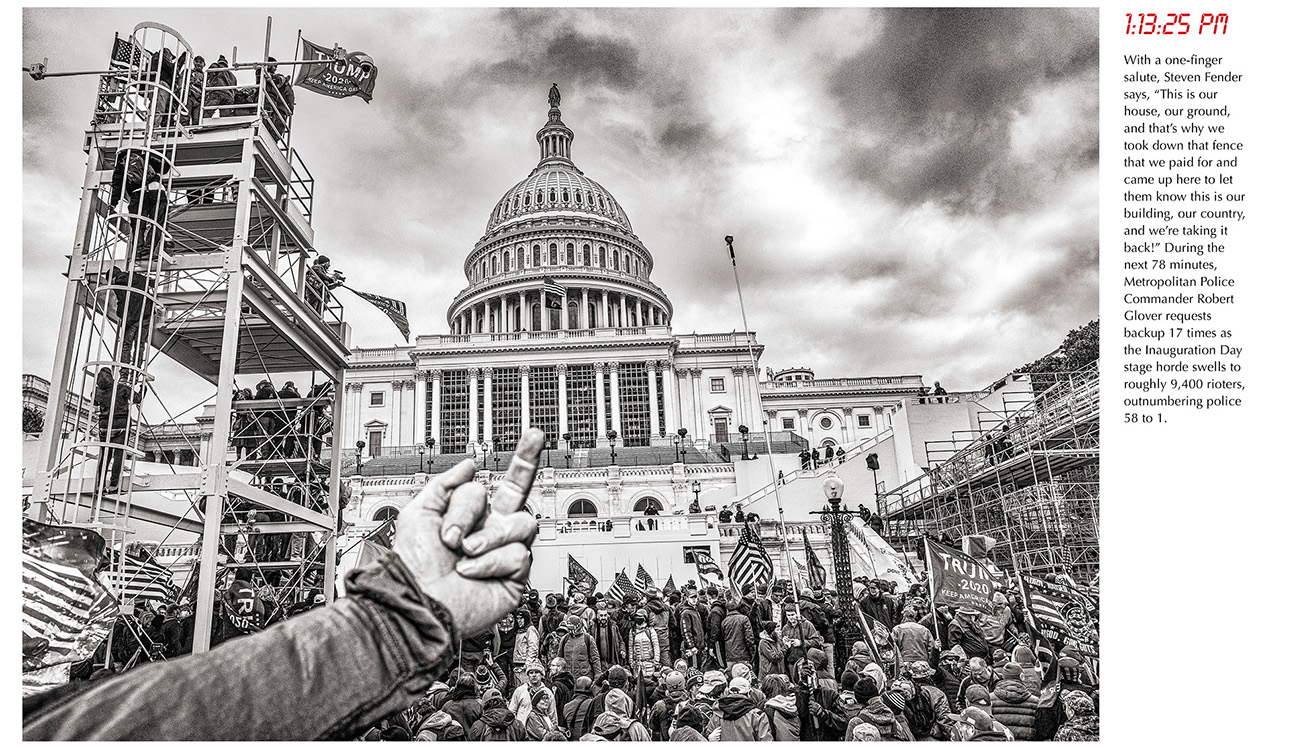
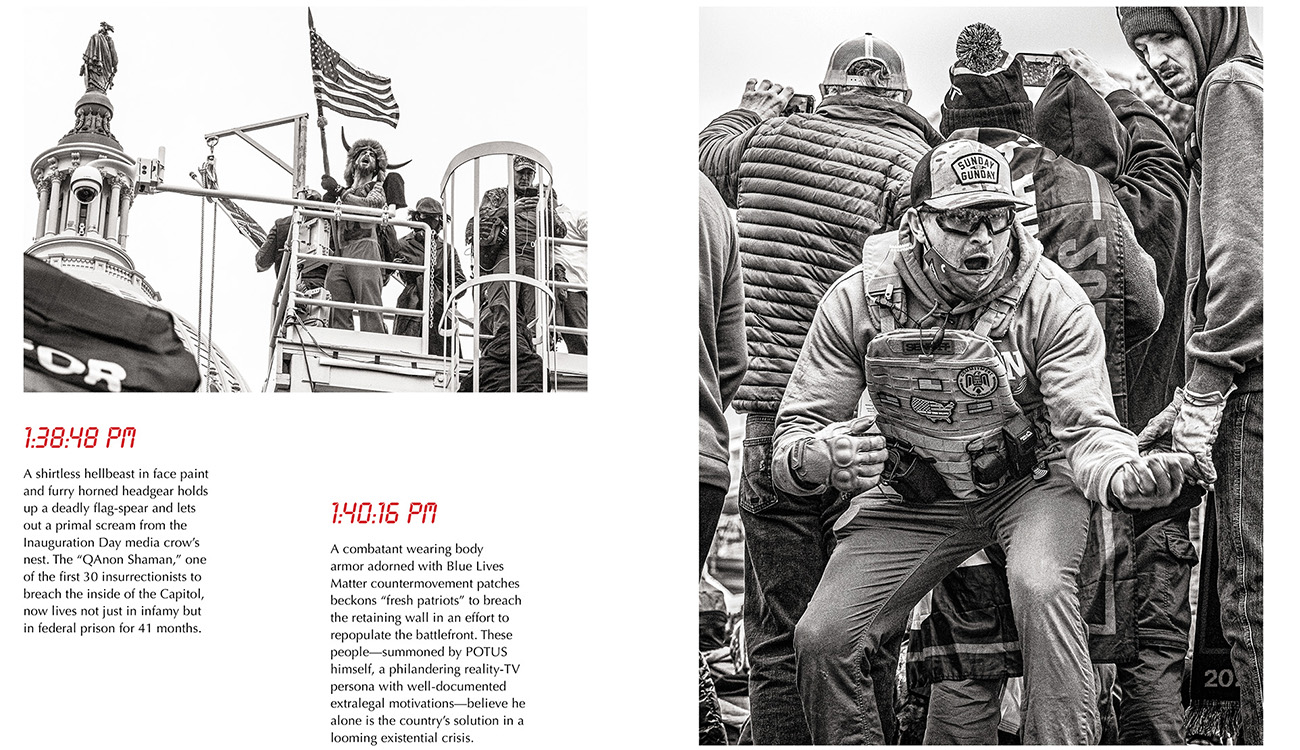
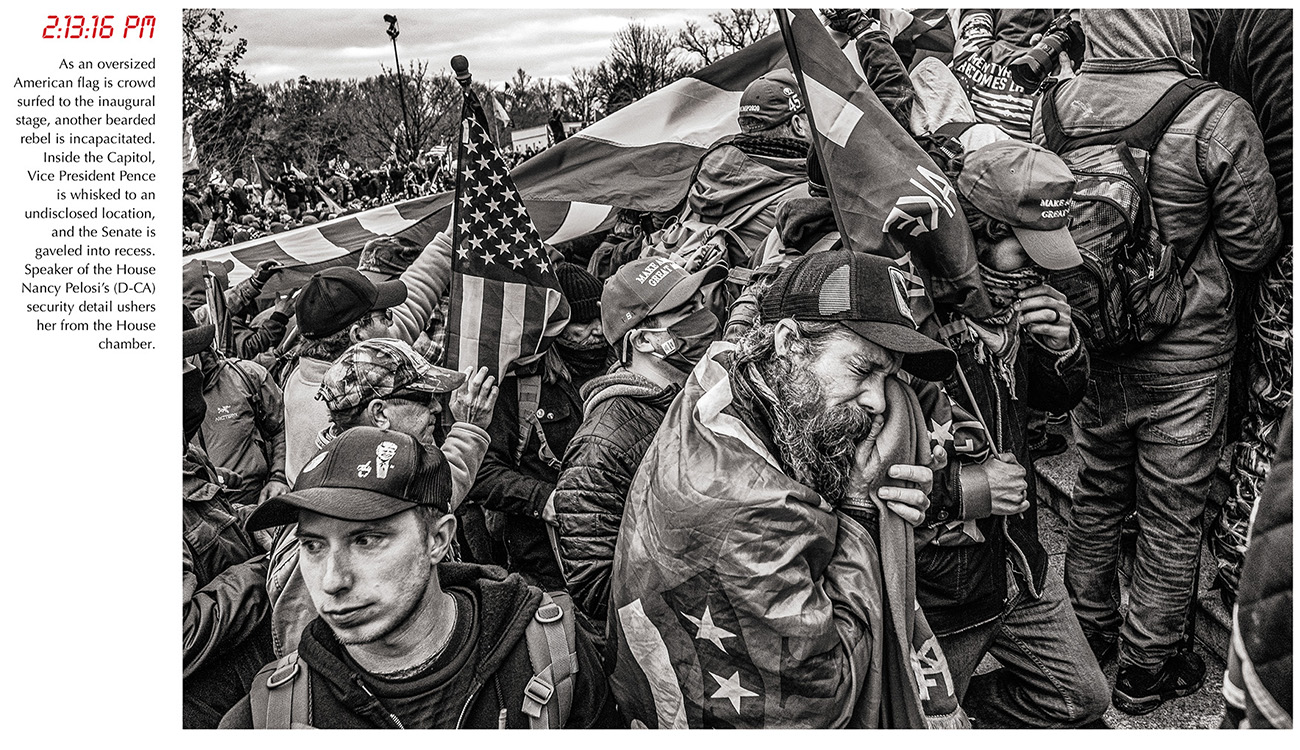
How were you feeling at the end of the day?
I felt hungry, dehydrated, and exhausted. Around 6:30 p.m., I left to trudge the several miles to my friends’ for my night of culling and processing photos, due to Rolling Stone by noon the next day. I had a lot of emotional processing to do that I am still learning about to this day.
As you headed back home to Seattle, you lost your camera equipment.. How did that happen?
Yes, besides the 25 medium-res JPEGs published by Rolling Stone online, this book’s photos were almost lost. On January 8 at Union Station, I was checking in with my dad over the phone when I realized I was late for my train. In my haste, I left my backpack at my seat—in it, my camera, hard drives, and laptop. I rushed back three minutes later, but my belongings had vanished.
I was devastated. When photo or audio gear is stolen, it’s never usually a happy ending for the original owner. In that moment, I would’ve given my health and wellness for my pictures back.
How did you get everything back? Were you surprised you were able to recover everything?
My community’s response was humbling. Probably a hundred people reached out with help and reassurance. If not for the sleuthing efforts of an acquaintance, this book would not exist. Just two days after the theft, he took to the online marketplace and found my camera. I messaged the seller that it was unmistakably my banged-up Leica Q and six-year-old laptop. Silence.
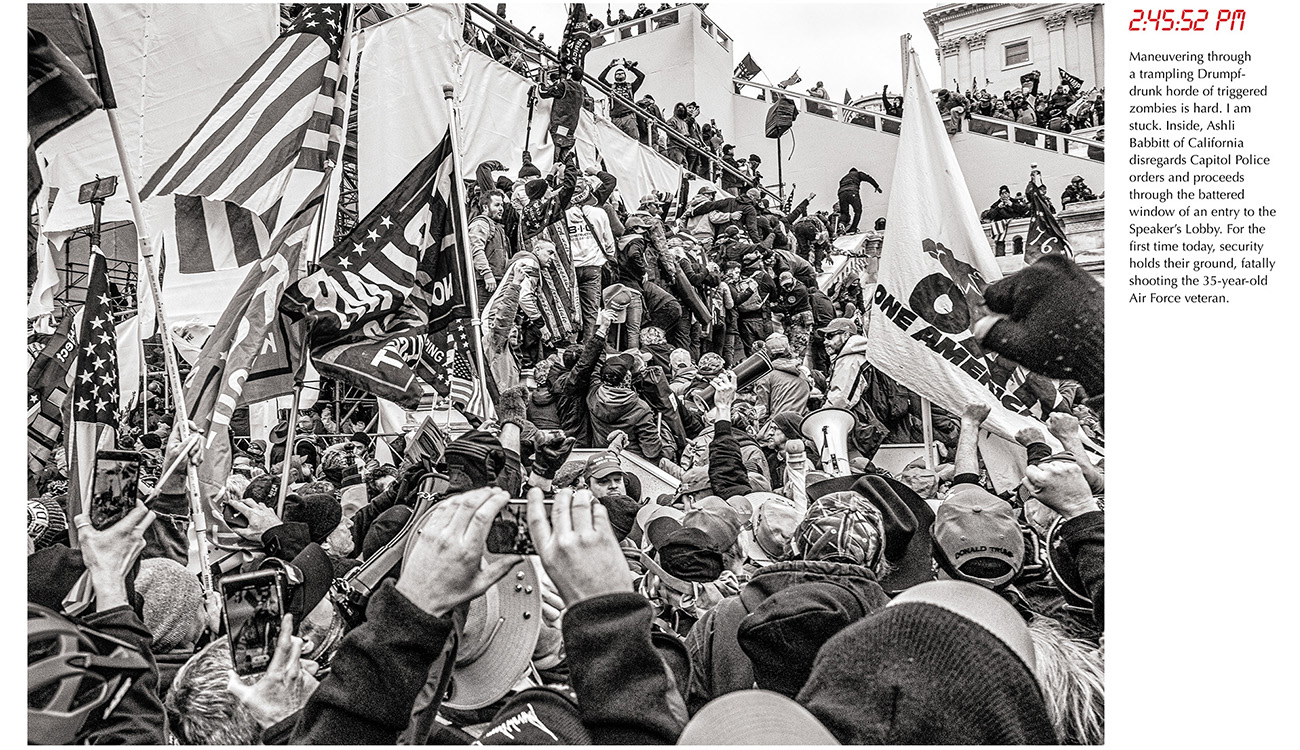
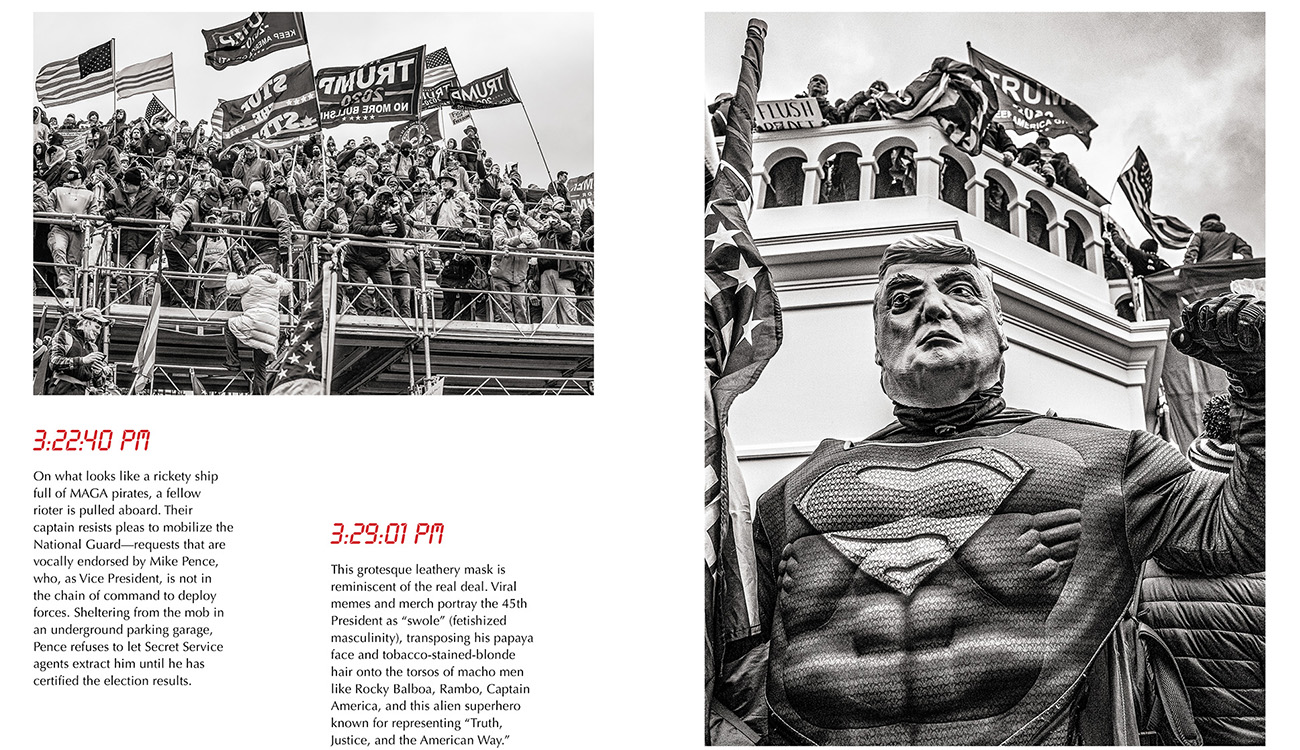
So close yet so far from recovering my things and particularly these images, I boarded my flight back to Seattle. I had little hope left. Upon landing, I learned that the seller wanted me to call them. Over the phone, they claimed that they had “found” my backpack. “Praise be to God,” they exclaimed, for putting us in a position to help each other—as they attempted to extort $2,000.
Very fortunately, the thieves agreed to return to the scene of the crime and to make the exchange the following day at Union Station with my friend. Amtrak Police officers went above and beyond to work with him to arrange a successful sting operation. For a multitude of reasons, I didn’t press charges. The detained individual was banned from Union Station, but didn’t spend the night in jail.
Jumping forward, how did the book project come about?
It’s important that people see what happened on January 6, 2021. To my knowledge, and astonishingly, no one had yet put out a visual chronicle of that day in book or magazine format.
In September 2021, I met my partner at the time’s parents. She not only warned me not to bring up politics with them, but to redirect the conversation whenever her father would try to bait me into going there. Our day went smoothly until dinnertime. With a couple of drinks in us, I made the mistake of referring to January 6 as “the insurrection.” “What insurrection?!” his voice boomed.
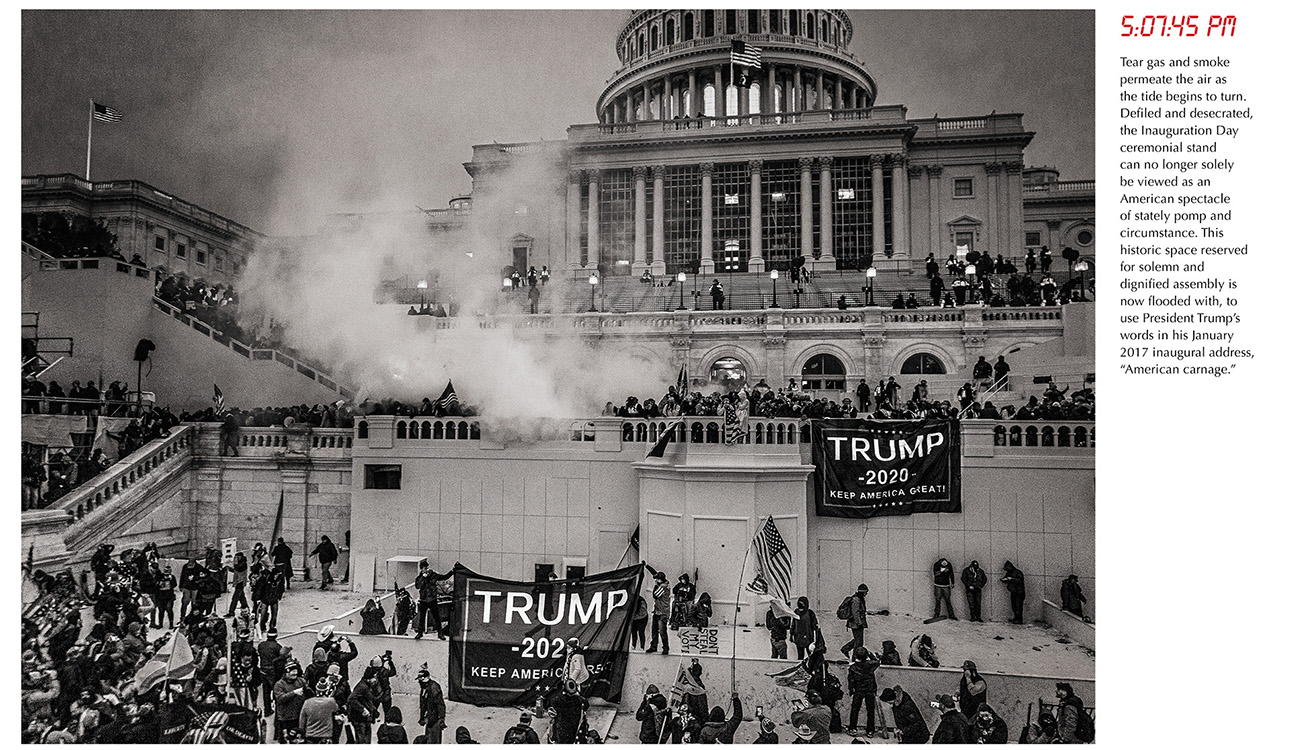
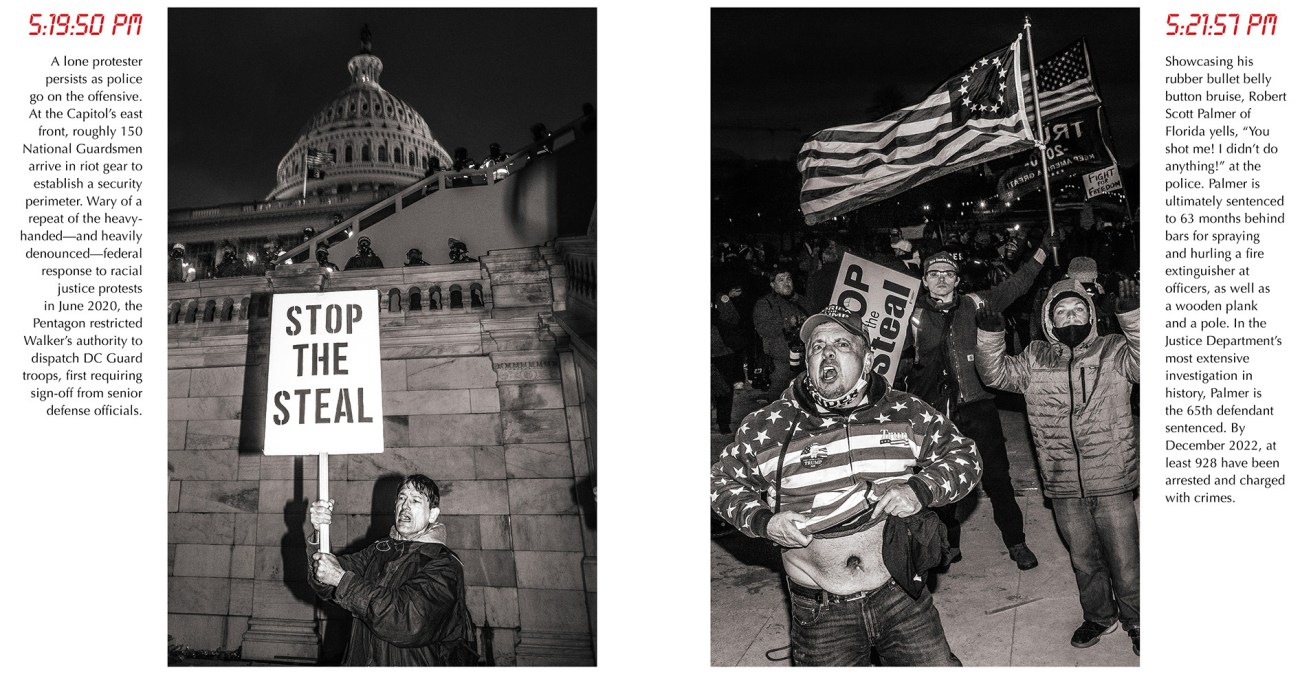
My labeling of January 6 as an insurrection triggered both of her parents, which didn’t help my relationship but did ultimately solidify my resolve in making this book a reality.
How many images are in the final book, and how many did you edit it down from?
The book contains 124 time-stamped images from January 6. Total, I have 2,850 frames from that day.
Did you look for a publisher or did you set out to publish it yourself?
Without connections within the publishing industry, I couldn’t afford to take time to navigate that world. Having spent ten months in 2020 working overtime to co-author and produce a 100-page coffee-table book celebrating LGBTQIA+ students, staff, and families of Seattle Public Schools, I figured I was already familiar with much of what I’d be up against in my decision to self-publish.
How would you describe the learning curve in terms of putting the book together? Going into it, did you feel like you knew more than you actually did?
The learning curve has been huge. I assumed that curating one day’s portfolio would be less time consuming than a best-of tome of my years of watching Trump punch us through the Overton window daily. However, I severely underestimated the storytelling it involved to synthesize one day’s chaotic narrative into a digestible account.
Choosing the book’s images came naturally. What took months was pairing and contextualizing those images alongside 5,000 words of what I was seeing and thinking on the ground, while detailing the essential plot points. For 14 months, I filled my head with everything I could in order to honestly and accurately boil down the events of that day.
This monograph represents the climax of five years of tunnel-vision obsession with our American political dysfunction. It’s been daunting but rewarding and depressing navigating this space.
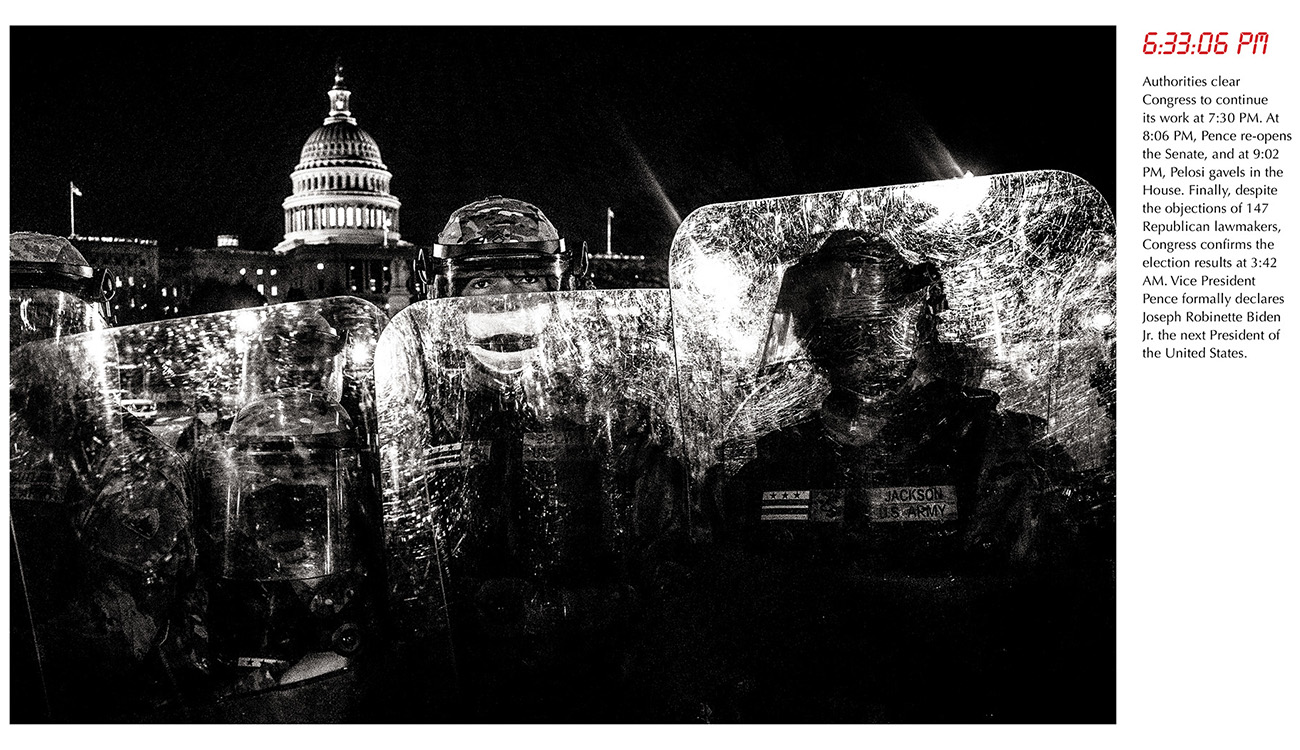
What was the most important thing you learned in putting this together?
The most important thing I learned was that doing something right will always take me longer than I think it will. You can invest 80 percent of a project’s timeline on the last 20 percent. I thought I would be finished last January, and here we are, a year later. No matter how much I want to turn the page on my career creatively, I’ve gotta see this one through by promoting it and selling books.
In September, I put out a softcover preorder edition. I worked with a local printer that doesn’t normally specialize in art books but delivered on my budget. Then, using everything I’d learned from doing that run, I created the revised 6-by-8 and 9-by-11 hardcover editions, which are basically that first edition but with five more months of design and typesetting expertise under my belt, with the addition of DC Metropolitan Police Officer Daniel Hodges’ powerful foreword.
For these hardcover editions, I was so lucky to connect with a printer I absolutely adore, Conveyor Studio out of New Jersey. I’m so thankful I found an editor, Lisa van Dam-Bates, whom I’m on the same page with. If it wasn’t for the hours she put into it, this book wouldn’t be what it is. I am also deeply appreciative of Officer Hodges and author Michael Rowe for their words in the book’s foreword and introduction. They both nailed it.
What has the reception been like so far?
The softcover first-edition run of 666 books sold out in September. Earlier this month, I got an email that read, “We were visiting a friend last night and saw your photo journal of January 6. As hard it was to view, here I am in the middle of the night attempting to purchase the book. Please let me know if it may be available in the future. It’s something I want my grandchildren to see, study, and know.”
Pre-orders on my website have been trickling in for the new hardcovers, of which we’ve printed 1,500 books total. I’d be lying if I said I wasn’t scared to death they don’t sell the way I need them to for this to work financially, but I’m glad I’m trying. I would have regretted it forever if I hadn’t. I want people to hold this book in their hands to remind them, “Yeah, that happened. Let it never happen again.”

Have you by chance heard from anyone in any of your photos?
No, I haven’t. But I’m priming myself for mail that isn’t as kind as that note.
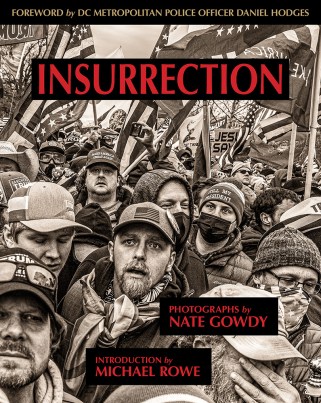
All images from the book Insurrection.

